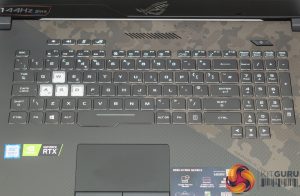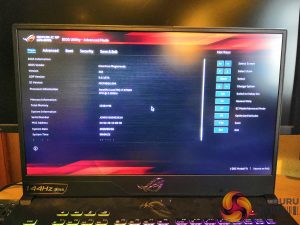Overall Design
The design of the ROG STRIX RTX SCAR II is sleek and reasonably under-stated. It uses a faux-brushed metal cover on the lid and military camouflage over one diagonal half of the keyboard area. The display has a narrow bezel which allows for the 17.3 inch display to be squeezed into a slightly smaller form factor than its predecessor, 40mm wide vs 41.4mm on the first SCAR.
The Republic of Gamers (ROG) logo on the back of the display lights up when turned on, along with the RGB keyboard and RGB strip along the lower front edge of the chassis.
Being plastic rather than metal, the faux brushed metal chassis is remarkably finger-print resistant.
Underneath there are a number of intake vents and rubber feet. Be careful not to block those intake vents when gaming as temperatures are already high, blocking vents will only cause throttling and impair performance.
The thickness of the laptop varies slightly from front to back, it's about 2.5mm at the front and 2.65mm at the back. Even so, it's not that thick considering the hardware on offer, as the pound coin for reference demonstrates.
There is venting around the chassis including on the right hand side, but not the left, and along the entire length of the back.
That ventilation system which ASUS calls “HyperCool Pro” includes a pair of 12v fans, a large thermal heat-spreading plate, “self-cleaning anti-dust tunnels” and a “Hyper Fan” mode (activated with FN + F5, “Turbo” mode) to keep things cool under heavy load.
There are four indicator LEDs located above the speaker, or visible from the back when folded, that indicate charging, power, hard drive activity and air-plane mode status.
The display hinge is robust, this angle also shows just how thin the display unit is.
Connectivity
The overall connectivity is very generous and provides the following:
- 1 x USB 3.1 Gen 2 (10Gbps, Type-C)
- 3 x USB 3.1 Gen 1 (5Gbps)
- 1 x USB 3.1 Gen 2 (10Gbps)
- 1 x mini Display Port 1.4
- 1 x HDMI 2.0b
- 1 x RJ-45 LAN
- 1 x SD card reader
- 1 x 3.5mm headphone and microphone combo
- 1 x Kensington lock port
Keyboard, Trackpad and Speakers
The keyboard is large, taking up most of the available space and on the whole is clear to read and well laid out. It is no mechanical offering for sure, but it is pleasant to use and the AURA RGB lighting adds some flair.
The small sized enter key is somewhat frustrating, though, users may often find themselves pressing shift or # by accident while they adjust to the keyboard design.
The WASD keys are designed differently, to stand out for FPS gaming, but in practice they feel no different in terms of key press and actuation to the other keys. The number pad on the right as well as the arrow keys are much narrower than normal, to allow the rest of the keyboard to be larger.
There are a few macro keys for volume adjustment, microphone mute and a button to open the ASUS ROG “Armoury Crate” which allows you to set the power profiles (Windows/Silent/Balanced/Turbo/Manual). Balanced is the default and that is how we tested.
The power button on the keyboard has a red illumination when the laptop is on. When the laptop is turned on on from “power off” (i.e. not standby) or restarted it makes a rather loud “swooshing” noise, deliberately and out of the speakers, which is somewhat obnoxious. This can be turned off in the BIOS.
The trackpad is “average” – it holds a bit of resistance to the finger and can be fiddly sometimes but it works for its intended uses, which are not gaming. Most users will skip over the trackpad and go straight for the ASUS-provided ROG Gladius II mouse which is very good mouse and more than capable of handling any FPS game in comfort and style.
The only issue is ASUS does not provide a mouse mat to go with the Gladius II. Given the overall cost of the laptop and the fact they included a mouse in the first place it seems strange to have not included an ASUS branded mouse mat to complete the package.
Under extended system use the keyboard area does get warm, but nothing uncomfortable because the cooling is well handled by the dual-fan system using rear and side exhausts.
The AURA implementation is more than bright enough and offers easy control using the FN key and the AURA hotkeys on the navigation arrows; left and right change the operational mode and up and down change the brightness. The implementation is a “4-zone” design, which you can see from the picture above by the way the colours split.
Display
The 1920 by 1080 full HD display is a real pleasure to use with its IPS panel, rapid response times and high refresh rate. The anti-glare coating works reasonably well but in direct light there is still some glare that is visible, though that glare is trivial in comparison to glossy displays equipped on some other laptops.
The display is the real highlight of the laptop – it's a pleasure to look at from all angles, it's more than bright enough and it's responsive and vivid for all types of gaming from FPS to Strategy. However, it has one major let-down for many avid gamers which is the lack of G-Sync support.
The 1920×1080 resolution is sometimes “labelled” dated in this day and age but in practice, on a screen of this size, it is still the best choice especially when you consider that the 1080p resolution is what facilitates the high 144Hz refresh rate and low 3ms response time. A panel of higher resolution, such as 1440p, would not be nearly as forgiving for FPS gaming.
There is a 720p/30FPS webcam located in the bottom right section of the display bezel, which includes a microphone too.
Inside
The cover is fairly easy to get off with a single screw driver and a plastic, not metal, pry tool to separate the bottom cover from the main laptop chassis. ASUS even provides a user guide on its product page on how to carry this process out.
The internals are neatly arranged and give a good look at that dual fan cooling system. Both fans intake from the bottom of the laptop but one exhausts out the rear only and the other out the rear and side. Heat pipes, fans and heatsinks are shared between the CPU and GPU.
The memory is arranged over two DDR4 SODIMM slots, only two modules are supported so the configuration is to be either 2 x 8GB or 2 x 16GB.
Some other coverage of this laptop has suggested ASUS is also shipping the 16GB variant with a single 16GB module, which could be detrimental to overall system performance by changing the laptop to single-channel, rather than dual-channel, memory operation. Prospective buyers should be cautious of this and check with their preferred retailer before buying if it represents a concern.
The NVMe SSD sits on a PCIe 3.0 X4 interface even though the Intel 660P M.2 NVMe SSD used performs more in-line with PCIe 3.0 X2 speeds, as we detail later on in the review. The good news is that users could, in theory, swap out for a faster NVMe M.2 SSD without too much hassle, but in practice the drive is still plenty-fast for typical usage.
The last observation is that the battery seems fairly small but this is understandable as gaming laptops spend most of their lives “plugged in” and therefore the priority is more towards performance components than battery life when allocating chassis space.
UEFI
The UEFI, entered into by pressing F2, is not overwhelmingly important with a laptop since there isn't anything significant that can be tweaked in terms of performance. However, the UEFI is clearly laid out and pleasant to use. Luckily for us, the obnoxious starting up noise can also be disabled under “Advanced”, “Animation Post Logo Configuration”, set this parameter to “Disabled”, then save and exit (F10).
 KitGuru KitGuru.net – Tech News | Hardware News | Hardware Reviews | IOS | Mobile | Gaming | Graphics Cards
KitGuru KitGuru.net – Tech News | Hardware News | Hardware Reviews | IOS | Mobile | Gaming | Graphics Cards


























